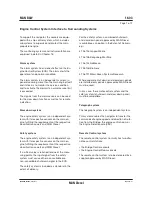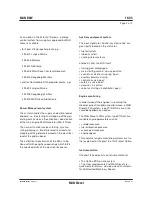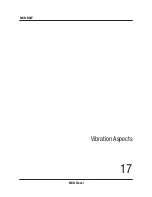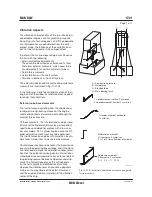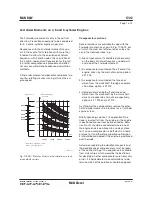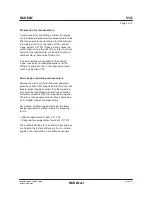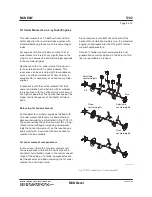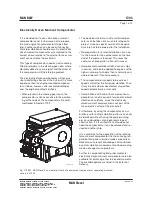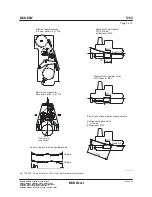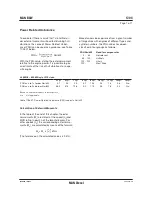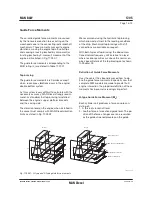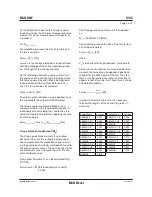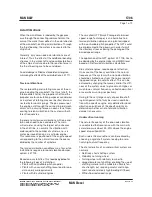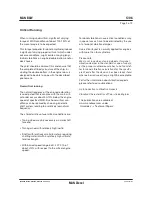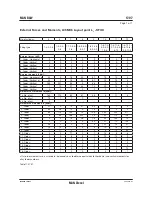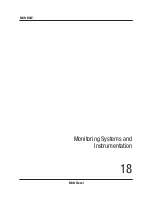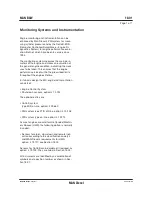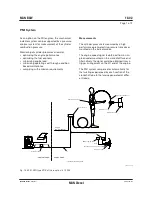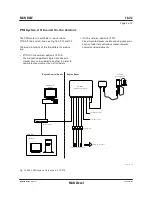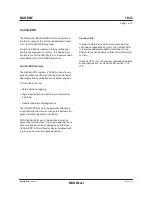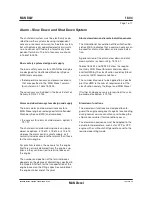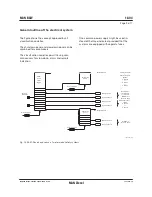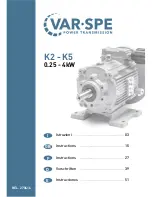
MAN B&W
17.06
Page 1 of 2
MAN Diesel
MAN B&W S90MC-C/MEC, S80MC-C/MEC, S70MC/MC-C/MEC/MEGI,
L70MC-C/MEC, S65MEC/MEGI, S60MC/MC-C/MEC/MEGI/ME-B,
L60MC-C/MEC, S50MC/MCC/ME-B/ME-C, S46MC-C/ME-B, S42MC,
S40MC-C/ME-B, S35MC/MC-C/ME-B, L35MC, S26MC
198 42 257.6
Axial Vibrations
When the crank throw is loaded by the gas pres-
sure through the connecting rod mechanism, the
arms of the crank throw deflect in the axial direction
of the crankshaft, exciting axial vibrations. Through
the thrust bearing, the system is connected to the
ship’s hull.
Generally, only zeronode axial vibrations are of
interest. Thus the effect of the additional bending
stresses in the crankshaft and possible vibrations
of the ship`s structure due to the reaction force in
the thrust bearing are to be considered.
An axial damper is fitted as standard on all engines,
minimising the effects of the axial vibrations, 4 31 111.
Torsional Vibrations
The reciprocating and rotating masses of the en-
gine including the crankshaft, the thrust shaft, the
intermediate shaft(s), the propeller shaft and the
propeller are for calculation purposes considered
as a system of rotating masses (inertias) intercon-
nected by torsional springs. The gas pressure of
the engine acts through the connecting rod mech-
anism with a varying torque on each crank throw,
exciting torsional vibration in the system with dif-
ferent frequencies.
In general, only torsional vibrations with one and
two nodes need to be considered. The main
critical order, causing the largest extra stresses
in the shaft line, is normally the vibration with
order equal to the number of cylinders, i.e., six
cycles per revolution on a six cylinder engine.
This resonance is positioned at the engine speed
corresponding to the natural torsional frequency
divided by the number of cylinders.
The torsional vibration conditions may, for certain
installations require a torsional vibration damper,
option: 4 31 105.
Based on our statistics, this need
may arise for
the following types of installation:
• Plants with controllable pitch propeller
• Plants with unusual shafting layout and for spe-
cial owner/yard requirements
• Plants with 8cylinder engines.
The socalled QPT (Quick Passage of a barred
speed range Technique), is an alternative to a
torsional vibration damper, on a plant equipped
with a controllable pitch propeller. The QPT could
be implemented in the governor in order to limit
the vibratory stresses during the passage of the
barred speed range.
The application of the QPT, option: 4 31 108, has to
be decided by the engine maker and MAN Diesel
based on final torsional vibration calculations.
Sixcylinder engines, require special attention.
On account of the heavy excitation, the natural
frequency of the system with one-node vibration
should be situated away from the normal operat-
ing speed range, to avoid its effect. This can be
achieved by changing the masses and/or the stiff-
ness of the system so as to give a much higher, or
much lower, natural frequency, called undercritical
or overcritical running, respectively.
Owing to the very large variety of possible shaft-
ing arrangements that may be used in combina-
tion with a specific engine, only detailed torsional
vibration calculations of the specific plant can
determine whether or not a torsional vibration
damper is necessary.
Undercritical running
The natural frequency of the one-node vibration
is so adjusted that resonance with the main criti-
cal order occurs about 3545% above the engine
speed at specified MCR.
Such undercritical conditions can be realised by
choosing a rigid shaft system, leading to a rela-
tively high natural frequency.
The characteristics of an undercritical system are
normally:
• Relatively short shafting system
• Probably no tuning wheel
• Turning wheel with relatively low inertia
• Large diameters of shafting, enabling the use of
shafting material with a moderate ultimate ten-
sile strength, but requiring careful shaft align-
ment, (due to relatively high bending stiffness)
• Without barred speed range
Summary of Contents for B&W L35MC6-TII
Page 4: ......
Page 10: ......
Page 18: ......
Page 19: ...MAN B W MAN Diesel Engine Design 1 ...
Page 20: ......
Page 35: ...MAN B W MAN Diesel Engine Layout and Load Diagrams SFOC 2 ...
Page 36: ......
Page 52: ......
Page 64: ......
Page 65: ...MAN B W MAN Diesel Turbocharger Selection Exhaust Gas By pass 3 ...
Page 66: ......
Page 72: ......
Page 73: ...MAN B W MAN Diesel Electricity Production 4 ...
Page 74: ......
Page 95: ...MAN B W MAN Diesel Installation Aspects 5 ...
Page 96: ......
Page 132: ......
Page 146: ......
Page 147: ...MAN B W MAN Diesel List of Capacities Pumps Coolers Exhaust Gas 6 ...
Page 148: ......
Page 171: ...MAN B W MAN Diesel Fuel 7 ...
Page 172: ......
Page 186: ......
Page 187: ...MAN B W MAN Diesel Lubricating Oil 8 ...
Page 188: ......
Page 203: ...MAN B W MAN Diesel Cylinder Lubrication 9 ...
Page 204: ......
Page 213: ...MAN B W MAN Diesel Piston Rod Stuffing Box Drain Oil 10 ...
Page 214: ......
Page 215: ......
Page 217: ...MAN B W MAN Diesel Central Cooling Water System 11 ...
Page 218: ......
Page 223: ...MAN B W MAN Diesel Seawater Cooling System 12 ...
Page 224: ......
Page 234: ......
Page 235: ...MAN B W MAN Diesel Starting and Control Air 13 ...
Page 236: ......
Page 242: ......
Page 243: ...MAN B W MAN Diesel Scavenge Air 14 ...
Page 244: ......
Page 256: ......
Page 257: ...MAN B W MAN Diesel Exhaust Gas 15 ...
Page 258: ......
Page 272: ......
Page 273: ...MAN B W MAN Diesel Engine Control System 16 ...
Page 274: ......
Page 289: ...MAN B W MAN Diesel Vibration Aspects 17 ...
Page 290: ......
Page 304: ......
Page 305: ...MAN B W MAN Diesel Monitoring Systems and Instrumentation 18 ...
Page 306: ......
Page 328: ......
Page 329: ...MAN B W MAN Diesel Dispatch Pattern Testing Spares and Tools 19 ...
Page 330: ......
Page 360: ......
Page 361: ...MAN B W MAN Diesel Project Suppport and Documentation 20 ...
Page 362: ......
Page 371: ...MAN B W MAN Diesel Appendix A ...
Page 372: ......

